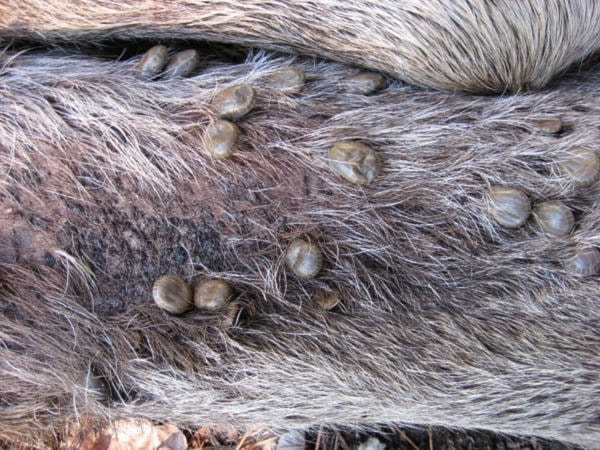The Yukon’s soil contains two strains of fungi that serve as a natural controller of winter ticks, a new study has found, with both strains specially adapted to thrive in the northern climate and a particularly gruesome method to dispatch of the parasites.
The strains — Mortierella alpina and Penicillium expansum, or M. alpina and P. expansum for short — are the stars of a paper that recently appeared in the annually-published Studies in Fungi journal.
To study the Yukon strains of the fungi, lead author Jay Yoder, a microbiology professor at Wittenberg University in Ohio, enlisted the help of Yukoners including veterinarian Michelle Oakley and Champagne and Aishihik First Nations’ Monica Krieger, to send him local soil samples.
(Krieger and Oakley are also listed among the paper’s eight authors.)
Yoder’s lab then isolated the two strains of fungi from the soil and grew samples of each in a sterile environment, observing the effect of temperature and moisture on their growth.
M. alpina can grow in temperatures between 5 C to 30 C while P. expansum grows between 5 C to 35 C (both saw peak growth at 25 C), the study found.
The lab also raised winter tick larvae and then treated different groups of them with spores from the fungi as well as a commercial product called Met52.
All three treated groups had shorter survival times that a control group of larvae treated with a saline solution — while the saline group lived about 11 days, the Met52 group lived about four days, the M. alpina group about seven days and the P. expansum group, nine days.
The study also confirmed how both Yukon fungi strains infect and kill winter tick larvae, which basically boils down to sucking all the water out of the parasites.
“Ticks become infected by these fungi as a result of spore exposure. Upon contact, spores stick to the outside of the tick, germinate into hyphae, and gain access to inside the tick by penetrating through the mouth, anus, and soft cuticle between leg segments,” the paper reads.
“As the fungus takes over, the tick dies, becomes enveloped within the fungus mycelium, and dries, producing a dried-up tick mummy. The tick mummy subsequently serves as a secondary source of spores that can infect ticks that are co-occurring within the same region.”
M. alpina-infected larvae showed a higher water loss rate than P. expansum-infected ticks, the study found, which is why the M. alpina-infected group died off faster.
In an interview July 31, Yoder told the News that the study’s findings offer a valuable insight into the Yukon’s naturally-occurring tick-fighting resources, opening up the possibility of using them as part of a comprehensive tick-management plan.
Winter ticks have become a serious issue down south, Yoder explained, with American states like Maine, New Hampshire and Vermont seeing up to 70 per cent of their moose calf populations being killed off by the pests.
There’s now growing concern that winter ticks are moving north into areas that they typically weren’t seen before, and over the impact they could have on local wildlife populations.
(According to Environment Yukon’s website, winter ticks are currently present on about half of all elk and deer in the territory and “very few” moose and caribou.)
“This is a very important area right now as far as preventing this tick from getting through the Yukon and getting up into Alaska, where this tick could be threatening not only the moose populations there in the Yukon but also the moose populations in Alaska,” Yoder said.
“What these fungi would be useful for would be as one of the new technologies that would be part of an integrated winter tick management program. … These are fungi that can be part of a new technology towards an integrated sort of winter tick management program that could be put into place, and there are multiple things that can be done in terms of habitat modification, landscape modification, also animal trail modifications. There are a number of different steps that can be put into place and having these fungi available could be part of those steps that would be useful towards overall control.”
Because of the Yukon fungi strains’ tolerance to lower temperatures, there’s also the potential for them to be used as part of tick-management plans in other areas with cold climates, Yoder said, although a wider application of the fungi isn’t something he’s studied yet.
He added that he would like to do more research on winter ticks in the Yukon, as well as help with the design of an integrated tick management program for the territory.
Contact Jackie Hong at jackie.hong@yukon-news.com
